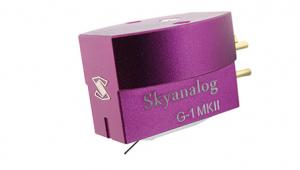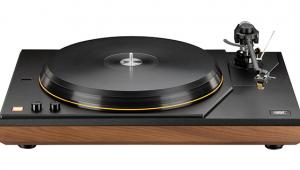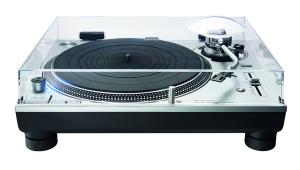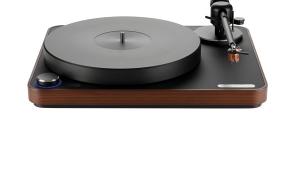Thorens Td 309 (£1250)
Looks can be deceiving. At first glance, you might think that the TD 309 was designed just as an eye-catcher, but in reality it is easily the most radical and innovative turntable Thorens has produced since the company was revived around ten years ago by the dynamic Heinz Rohrer. For the TD 309 project, Rohrer called in Fink Audio Consulting of Essen in Germany, best known for its expertise in loudspeaker design. But, as Karl-Heinz Fink says, ‘We are all turntable guys! We like turntables! And if you work on loudspeakers, you deal with vibration at a micro level, dealing with problems that are similar.’
SPRING-DRIVEN THING
Despite appearances, the TD 309 is a true suspended-subchassis design, but the subchassis actually is the top plate of the deck. The suspension springs are hidden underneath, mounted at the corners of a moulded triangular support which forms the primary chassis. Most companies that still make subchassis turntables have moved away from the coil springs used on the seminal Acoustic Research design and the classic Thorens models which followed. Even Thorens switched to leaf springs quite early on, while others substituted rubber-type materials. But coil springs were chosen for the TD 309 in order to get the resonant frequency down to a very few Hertz. This is difficult to achieve with rubber. Leaf springs were rejected as they tend to be stiffer in one direction than the other. One problem with coil springs is that they can allow the subchassis to wobble sideways as well as moving vertically in the intended axis of the spring action. Loudspeaker technology provided a solution here. Each spring’s upper housing is collared with a flexing membrane just like a speaker voice-coil suspension. In the classic subchassis turntables, the motor is mounted on the main chassis, driving the subchassis-mounted platter by a belt. This means that subchassis movements will affect the drive’s stability, while the belt inevitably forms an unwanted part of the suspension. So on the TD 309, the motor is mounted on the subchassis, in this case the main top plate, instead. It is decoupled by its special mounting, again using loudspeaker-type ‘spiders.’ One is visible at the top and another is hidden at the bottom of the motor. Belt tension can be adjusted, after loosening a single retaining bolt, by turning this whole suspended motor unit in its eccentric mounting. In the past, as Fink says, ‘Everybody and his dog used the same little Philips synchronous motor.’ But one of the Thorens design criteria was that there had to be switching for 33 and 45 rpm, which with a synchronous motor would have meant resorting to old-style mechanical belt shifting. So the motor is a modern DC type, powered via a carefully-designed electronic speed control circuit which is housed under the deck at front left, with a 33/off/45 switch accessible just under the front edge. Tiny screw adjusters are provided to allow fine pitch (speed) adjustment if needed.
FROM BELT TO BRACES
After some experiments with third-party tonearms it was decided that the TD 309 had to have its own dedicated Thorens arm, and the design team tried to find the most logical way of getting good performance within the cost constraints. The result was the TP 92. Its four bearings are ball-races sourced from MMB (Micro Miniature Bearing Company) of Japan, which provided a type used in measuring instruments. Freedom from stiction when moving very slowly was thought more important than a high ABEC precision rating, which is more relevant to high-speed use. Fixed into the neat but massive-enough bearing block is a straight aluminium arm tube. The single bolt headshell fixing resembles the type used by Clearaudio, but in fact the idea originated earlier with Thorens. The cartridge platform has a saddle-shaped top which sits snugly in the cut-away end of the tube. It cannot rotate but can be moved back and forth to change the arm overhang by 2.5mm, enough to allow the correct alignment with most cartridges. This makes it easy to set the alignment and keeps the cartridge on the axis of the arm, avoid the twisting modes that occur with offset headshells. There is a minor drawback, which is that hex bolts with deep heads can’t be used. Also, as the carrier is very thin where the holes are countersunk, you will need shorter-than-usual bolts if mounting a cartridge with ‘blind’ holes. From a resonance point of view, says Fink, it would be better to mount the cartridge part way along the arm rather than at the end, but this is hardly practical. In the end, a special vibration damper was added, in the form of a decoupled metal ring placed at a critical point near the middle of the tube. The method employed here resembled work Fink had done with BMR (Balanced Mode Radiator) loudspeaker drivers. At the back of the arm, a threaded stub at low level holds the counterweight, which as usual needs to be wound forward to apply tracking force. Finally, to get you started, the package includes a basic Audio Technica AT95B moving-magnet cartridge.
MAKING SENSE
Listening started with the budget Audio Technica, but what I heard was a pleasant surprise. On Dave Brubeck’s ‘Blue Rondo A La Turk’ from Time Out [CBS 62068], the piano was admittedly rather pinched, but it still had a rather admirable punchiness. Gene Wright’s bass was firm and springy. With Eric Clapton’s Slowhand [RSO 2479 201, 1977], the Thorens seemed to dig out detail in a comprehensible way so that the songs made sense. The bass on ‘Lay Down Sally’ seemed full of bounce and well shaped, never becoming a muddy boom, as it can with this track. Would the humble AT release the magic from the grooves of Joni Mitchell’s Blue [Reprise KK4128]? It did. The sound was a little thin, bright and almost keening at the top and coarse in the midrange. But it had that un-fakeable quality of immediacy, of instant communication from the performer. Even if the AT95 hasn’t quite been around since Dire Straits [Vertigo 9102 021] came out in 1978, listening to this combination was suddenly nostalgic, as if I was revisiting the sounds of yore. But it was much better than that suggests, giving a stable and solid image. Turning to a classical favourite, Sir John Barbirolli Conducts English String Music [EMI ASD 521], I found a surprisingly good sense of depth and of the hall acoustic. What had seemed like a veiling, on the Clapton record for example, became an acceptable mistiness here. So how would the TD309 perform with a cartridge upgrade? My first move was to install the Ortofon 2M Red, which sells at around £80. Now, with ‘Blue Rondo A La Turk’, the rather thinned piano sound wasn’t exactly fleshed out, but it acquired more detail and plangency. Morello’s struck cymbal accents were now more striking, you might say, ringing out with bell-like clarity. Clapton’s ‘Wonderful Tonight’ from Slowhand did sound fuller and richer, with better detail. ‘Lay Down Sally’ rocked along, Clapton’s vocal now solid and tangible. With the Barbirolli record, the Ortofon gave a grander sense of scale and depth. Next step was to move up to a more luxurious moving-magnet, the excellent Roksan Corus Silver. Now Brubeck’s piano sounded more like a real one, having percussive impact as well as body, and the same applied to the other instruments. When Brubeck went into ‘Strange Meadowlark’, you could almost forget to give the usual shrug of resignation that, well this was a CBS record pressed in the 1970s. It sounded better than that. With Clapton’s ‘Wonderful Tonight’, the Roksan gave each strand of the music a more independent existence. ‘Lay Down Sally’ was crisply rocking, really foot-tapping and free of muddiness. I’d wondered whether Blue might sound a little over-bright with the Roksan, but it was just right, with Joni’s voice yearning and floating, getting you right in the heart, in a way it hadn’t done with the 2M.
MOVING ON UP...
Time to try a moving-coil. I watched the ruby cantilever of the Ortofon Cadenza Blue descend towards the first grooves of Time Out. Here was a very different, subtler sound, with rich textures just forcing you to realise, for example what an amazing sax player Paul Desmond was. Bass was deeper and the treble was smoothed out further. ‘Strange Meadowlark’ was lovely, the piano singing, and there was a stereo image you could walk around in. As for Eric, well, the Cadenza Blue lent a dreamy, velvety quality to ‘Wonderful Tonight’, EC’s voice pillowed in a complete spread of accompanying warmth. ‘Lay Down Sally’ was less punchy than with the Roksan, but the bass was deep and clean, the stereo stage expansive. Elgar’s ‘Introduction And Allegro’ now swept into the room with great panache, the fine bass quality underpinning the music, keying the size and sound of the hall, as well as making the double bass parts intelligible and meaningful. Finally, I installed the Koetsu Black. In contrast to the effortless precision and pleasing detail of the Ortofon, the Koetsu added its own gutsy dynamism, with a rather forward and well-textured midrange, relatively subdued high treble and a powerful if fairly unsubtle bass. Partnered with an inadequate deck, the Koetsu can end up sounding merely too forceful and rather coloured, but I felt that the Thorens really helped it to do its thing enjoyably. It could produce an immediate impact, or add an appealing romantic bloom, as on ‘Strange Meadowlark’. Clapton’s ‘Wonderful Tonight’ was rich and glowing, though the bass on ‘Lay Down Sally’ was just too much of a blurry thump. But the Koetsu sounded as if it was made to play Joni Mitchell, the guitars punchy, the voice sublime. With Barbirolli and Elgar, the Koetsu was more successful than the Cadenza in some ways, if without the final bit of dimensionality added by the former’s deeper bass. Yet it was more immediate sounding and perhaps more eloquent, too.
VERDICT
This modern turntable improves on classic subchassis virtues, with low coloration, excellent imaging, great bass and fine rhythm. It makes a ‘starter’ cartridge sound better than it has any right to, and when you move on to a really good moving-magnet, it is absolutely outstanding. Despite its moderate price, it will embrace even exotic moving-coils too. An exceptional product, which is warmly recommended.
Sound Quality: 85%
Originally published in the June 2010 issue

























































